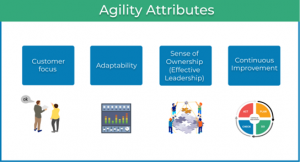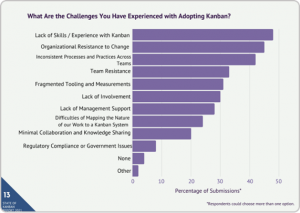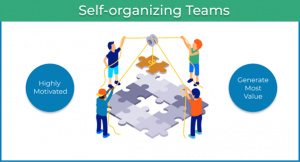A PDCS White Paper
It’s not a lie that here at PDCS, we are big fans of business agility. Every day, we read, write, research, and implement our new findings on Agile. We also give our best in our day-to-day work to practice what we preach. However, blindly preaching that a coin is one-sided, doesn’t wipe out the existence of the other side.
We won’t be these blind preachers. Agile is far from a silver bullet.
Simply adopting Agile methods without understanding what means to be Agile, won’t lead your organisation to a successful transformation. In addition, such change has its challenges and issues, which, if not addressed correctly, will inevitably lead to another failed transformation and another post explaining, “Why Agile doesn’t work.”
In this article, we’ll address the major challenges an organisation could face during an Agile transformation and how failures could be avoided.
And because we believe arguments should be backed up by data (if possible), we used two of the hottest 2022 reports in the Lean/Agile community.
Just don’t give up on Agile. It’s worth it.
Challenge 1: Resistance to change. A company’s culture clashes with Agile values.
It is hard to change the way people think and operate. The habits and beliefs of a big organisation are naturally deep-rooted. Typically, people do fight against change, and when Agile transformation is used to challenge them, they come out with phrases like “that’s how we’ve always done things around here” or “that never works here.”
Giving a room for a change implies that you’re admitting that whatever you’re doing currently might not be done the best way, or even worse, it may be challenging to a person’s established values. In this paper, we found out that the human-related perceptions about the change process have been the major transition challenges.
- Communicate the needs for change to your people.
People find it very easy to retain their old methods and processes except in the case when they are vividly presented with solid “whys” they need to embrace the transition to Agile. Thus, your organisation must communicate the needs for change to your people accurately.

- Address the desired results from the transition
Also, the management needs to address the desired result from this change. Whether you are looking to achieve a faster time to market or to increase the predictability of your process, your people will embrace more easily the change if they understand and believe in the desired result. You’ll find that some of the biggest problems with Agile originating from management are due to an old-fashioned perception of doing things.
Challenge 2: Lack of management support.
Inadequate management support is still one of the leading reasons why Agile doesn’t work for each and every case. To go Agile, all executives, middle-management, and senior management have to be aware that there will be some changes in project management practices – please note that Project Managers are often replaced with Scrum Masters & Delivery Managers in an Agile environment. They must understand the benefits of the upcoming Agile transformation, as well as the details of how this transformation will affect the operational aspects of the business. In order to support the Agile adoption adequately, they need to fully understand what is expected of them.
Also, lack of support can be split by department – it is often the case that IT departments adopt Agile relatively easily compared to the core business. The business is often the last link in the chain when adopting a company-wide Agile process and it is therefore important that the business is engaged at an early stage. Failure to do so will also result in a failed and a very much delayed Agile adoption.
- Communicate the benefits of the transformation and the expected support.
Communication and cultural issues can be easily mitigated through aligning with every level of management before the actual Agile transition.

Challenge 3: Lack of team ownership. Team resistance.
The resistance of some teams to adopt the Agile practices is still a huge obstacle to the success of Agile transformations and scaling.
Agile fights that internal culture by empowering team members in taking full responsibility for the ownership of their work and give up the habit of depending on what others tell them to do. Doing so effectively requires the project manager to encourage more communication among team members as well as more engagement with the project.
- Encourage participation and facilitate progress.
By increasing team member’s ownership of the process, they would be given the freedom to analyse and figure out how to come up with solutions by themselves whenever they encounter issues, instead of wasting valuable time waiting for approval after approval just for something to be done.

Moreover, when members focus on ownership, their engagement, and sense of belonging to the vision that the business preaches increases. Their work efficiency and productivity increase too while the resistance to change is naturally fading away. At the end of the day, it’s the team members that do the work for the customers, so it’s only natural their voice to be heard.
Lastly and ideally, no one person should be responsible for a particular task and that multiple team members should be able to carry out that task / role to ensure a good spread of skills & abilities and thus increase engagement, team ownership & productivity even further.
Challenge 4: Inconsistent processes and practices across teams.
Customer satisfaction is at the heart of the Agile approach and a leading principle. To achieve this, Agile frameworks such as Kanban suggest creating a network of services within the organisation. This network of services includes all departments, teams and individuals being able to self-organise around the work, collaborate and evolve the way they operate while driven by quality improvement. Improving the service, product and work processes to deliver greater value.

In order for this network of services to work, the people need to follow the same rules and apply the same principles. In other words, you need consistency to make Agile work for you. You need teams that communicate and collaborate. This entails cross-functional Agile roles or teams responsible for helping a project’s delivery.
- Create a network of services with cross-functional teams to ensure productive feedback.
Agile cross-functional teams work iteratively and incrementally, which maximises opportunities for feedback, ensuring that a working product is always available. Even though cross-functional teams are not a new idea, many organisations are still struggling to absorb this concept.
Conversely, Agile itself does not have to be implemented in an identical fashion for every team. It is this flexibility that allows Agile to be adopted in wide variety of areas. Teams can pick and choose how they wish to run their Agile team but it must still be Agile – i.e. the essential elements must be adopted for it to work.
Lastly, it is not absolutely necessary for all related process to adopt Agile – Change Management is one such area that is often a road block here for many companies due to ingrained Waterfall practices – your Agile team however should be flexible enough to cope and work around it as there will always be roadblocks to being Agile
Challenge 5: Poor communication and collaboration.
Communication plays a crucial role in Agile. Team members have to communicate constantly and efficiently for the project to work well.
Doing this right requires that the company provides proper communication channels and, most notably, for distributed teams.
Typically, in Agile organisations, teams are co-located, and Agile will be more naturally adopted. Being present in the same office facilitates the immediate flow of information and feedback.
Also, one benefit of having co-located teams is the availability of osmotic communication. It means that the information flows into the background hearing of the team members, making the cost of communication low and the feedback rate high.

- Make sure the flow of feedback is easy and quick.
However, in the reality we live in today, over 50% of all knowledge workers worldwide are expected to be working remotely by the end of 2021. In other words, the growing number of distributed teams and individuals working from their homes calls for ingenious ways to smooth the ways we communicate. The new norm is no longer “face-to-face” communication but to ensure the possibility for “direct” communication and collaboration.
Challenge 6: Fragmented tooling and measurement.
The Agile manifesto prescribes no particular method. To pick the ideal option, you need to consider the nature of the business, characteristics of the organisation as well as the advantages and disadvantages of different Agile approaches.
Another key prerequisite to your success with Agile is choosing the right tools like Jira.
Please note that tools will help the transition, but you need to stick to them. Fragmented data scattered across tools is overwhelming and can easily lead to work process disruptions.
- Customise the framework to reflect your project needs and be consistent when using tools and techniques.
Indeed, the Agile philosophy values individual and interactions over processes and tools; however, effective communication and collaboration play a crucial role in a successful Agile transformation, especially for distributed teams and large organisations.
After using a particular method well enough to gain significant experience, go ahead and customise it to suit your organisation or project needs. Make sure all project-related data and measurements are clearly defined.
Challenge 7: Lack of training and education.
Insufficient training and education on the Agile methods are among the top reasons why Agile transitions fail. To make it all work out for you, you need the knowledge and understanding of the Agile concept itself: its principles, values, practices, and frameworks. That’s where the Agile Coach is meant to help you.
The Agile coach/evangelist plays the role of a servant-leader who ensures the whole organisation succeeds with the Agile transformation. It is in their hands to educate throughout the organisation on how Agile practices work, train teams on how to think and approach decision-making in line with the Agile mindset and instate continuous learning.
- Aim at consistency in Agile processes, practices and use of tools.
Agile coaches impact greatly the transformation of the company culture toward the Agile mindset, change of existing processes, and more motivated teams.
Conclusion
“Going Agile” is more than just adopting a given method or framework for a single project. You need to have a solid reason before rushing into an Agile journey. If you just want to follow a trend, you better not do it. Try to figure out “Why do you want it?”
After you answer this question, you will feel much more comfortable to start your Agile journey. However, whether you commit to a particular method or you start by implementing some of the Agile practices, there will be day-to-day operational problems, and you might still find yourself wondering “why Agile doesn’t work”. Thus, it is crucial to have your company’s management support and experienced team members, which can help the mitigation of any problems, issues, or challenges that may occur along the way.
PDCS is a specialist Programme and Project Management Consultancy, we run maturity assessments of an organisations business and IT processes, people, and governance, enabling clients to operate appropriate, efficient, compliant, and above highly effective and repeatable Project Governance.

